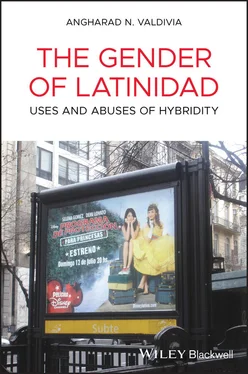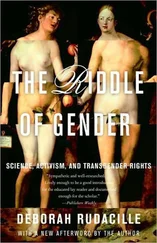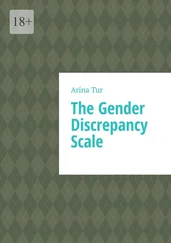The Gender of Latinidad addresses the contemporary situation of Latinidad, the dynamic process of signifying and performing Latina/o peoples and cultural forms, in the United States and, by implication, globally, as US popular culture is exported throughout the world. Focusing on three sites of intervention – historical and contemporary efforts by Latina actors who entered the mainstream as spitfires to construct an enduring career in entertainment; the ambiguous Latinidad constructed by Disney; and an exploration of the tensions within Latinidad about implicit and explicit utopias through the media – this book addresses Latinidad as a constant low‐intensity conflict of cultural engagement, negotiation, and deferment carried out by unequally empowered forces. On the one hand are individual Latina actors, who function as representatives of labor and cultural forces, and who seek to carve out a space of presence, belonging, and, hopefully, success. Some major examples are discussed individually in Chapter 2. On the other hand is mainstream media as a whole, with its global power and resources. In particular, Chapter 3focuses on the Walt Disney company, arguably the biggest global media conglomerate, as it engages in avowal and disavowal of Latinidad. The push and pull of forces come together in the desire for an ideal place, a utopia, whose internally contradictory contours are discussed in Chapter 4.
The book explores the concept of hybridity and applies it to the study of contemporary Latina/os. In particular, it seeks to complement documented demographic and political evidence of increased Latina/o presence with an understanding of the complex terrain of representations and narratives in the mainstream media. The Gender of Latinidad investigates some of the many ways that hybridity as a concept is strategically deployed in a range of contemporary media, with strong tendencies to resolve tensions by settling for syncretism. Hybrid launches land as syncretic culture. The energy that sends hybridity off settles in a domesticated manner. Efforts to contain hybridity and to harness it toward increased profitability, the commodification of Latinidad, coexist with unruly bodies and messy categories that threaten to interfere with neatly planned advertising and marketing campaigns, as well as official government efforts to account for, regulate, and service the Latina/o segment of the population. Indeed, the ongoing debates and controversies about Census categories reveal the fissures over both the definition of Latinidad and the acknowledgment of mixed race and hybridity as a challenge to that most official of population accounting. The tendency to “snap back” – that is, to retreat to old‐school ethnic categories – is great. It is always easier to rely on outdated yet neat categories than to engage in the far more difficult process of trying to understand and include heterogeneous populations whose lumping together originally occurred out of historical exigency and oppressive undemocratic goals, and not necessarily due to any empirical accuracy. Borders to the north and south of the United States effectively divided pre‐existing communities in the name of unifying the nation. Despite an undeniable increase in representation of Latina/os, production and representational analysis, findings are examined in terms of the gains in visibility against the costs, displacements, and erasures generated through it. Visibility is not the only goal. The questions of whose visibility and toward what purposes overlap with hybridity, as, in representing mixed cultures and populations, decisions have to be made as to what to foreground, and ipso facto what to displace or leave out.
Nonetheless, Latina/os compose a statistically significant percentage of the US population: 17.6% as of 2019. Projections predict Latina/o population growth, Latina/o consumer power growth, and Latina/o media consumption growth. Historical attention to the Northeast and Southwest has transitioned to acknowledgment that Latina/os are present in every region of the country. In addition to the “flyover” zone of the Midwest (not only Chicago, but other cities and the rural area), there has been Latina/o growth in the Southeast and the Northwest. In sum, Latina/os are part of the fiber of the United States. Latina/o presence has great implications for mainstream media, which prefers the male 18–34 age group as both media and general product consumers. Latina/os are a young demographic, and that fact could have positive expenditure implications for media industries, should they choose to exploit it, in terms of sheer ratings for television and box office receipts for movies. The gendered preference of mainstream advertising rhetoric about the most desired segment of the audience implicitly undervalues women. Exploiting this gender blindspot would be a great asset to media industries, which are constantly actively seeking new “niche” audiences, and would be an opportunity for Latina audiences to assert symbolic ruptures and cultural citizenship (Molina‐Guzmán 2010, 2018; Báez 2018).
Because viewership is but a point of entry into the synergistic merchandising, product placement, and tie‐ins accompanying any mainstream media circulation, media produced by conglomerates derives profit from integrated global marketing and advertising campaigns. The 18–34‐year‐old age group has been found to devote more time to media and to have the discretionary income to purchase the products and services implied by the media that it consumes. As the Latino Media Gap (Negrón‐Muntaner et al. 2014) documents, Latinos are overrepresented (in relation to their percentage of the population) as radio listeners, moviegoers, and social media participants. Thus, including Latina/os in general, and Latinas in particular in the production of media, in their representation and narratives, and in their target audiences seems like a win–win proposition. That this strategy is not being widely deployed once again illustrates that media production is not always about the bottom line but implicitly derives from ethnic and gendered omissions.
The Gender of Latinidad investigates specific representational strategies used in mainstream popular culture that differ, sometimes drastically, from previous efforts to account for and to reach ethnically diverse populations. Drawing on a wealth of research (Molina‐Guzmán and Valdivia 2004; Valdivia 2004a, b, 2005a, b, c; Harewood and Valdivia 2005; Calafell 2008; Moreman 2008; Molina‐Guzmán 2010; Cepeda 2015, etc.), the book seeks to map the deployment of particular ways of representing the “radical and dynamic relationality” resulting from population and cultural mobility (forced and voluntary). As Shohat (1991) has so brilliantly noted, ethnicities only make sense in relation to other ethnicities, and this is all the more true in the contemporary global situation. Ethnicities are discursive, in that they are deployments of power. They are not natural, as a brief tour of what constitutes Latina/o or blackness in separate nations will reveal. There is no such thing as an absolute ethnic identity or position. Ethnic positions shift across time and space. There is no such thing as a particular skin color – for, the very fact of identifying and naming a skin color results from a political, historical, and cultural context. 5 In the contemporary US moment, Latinas, for example, make sense in relation to whiteness and blackness. They/we occupy an in‐between location, regardless of our heterogeneity. Despite the fact that some Latinas are Afro‐Latinas, others are China‐Latinas, 6 and so on, we have been coded, for cultural purposes, as light‐brown Latinas. Our hybridity is erased in favor of that very useful in‐between location that serves many purposes at once. Light‐brown Latinas provide the US mainstream with a rationale of inclusivity. They can say, “hey, look, we are diverse.” This inclusion often displaces blackness, because why stop at that in‐between, why not just redraw the spectrum to white and light brown? It also excludes many if not most Latinas, as it displaces blackness and foregrounds whiteness as normative (Shuggart 2007). It coexists uneasily with other ethnicities, such as Asian Americans, Native Americans, and Arab Americans, whose skin color and ethnicization also place them between the white and black poles that rule the United States' racial spectrum.
Читать дальше












